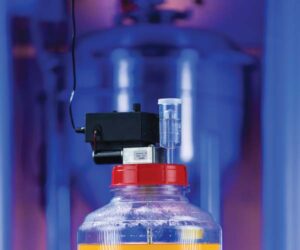Build a Stir Plate

One of the most useful tools for making a yeast starter is a product called a stir plate. A stir plate is a device that contains a strong magnet just beneath its surface that spins in a circular motion. A container of liquid sits on top of the stir plate, and placed inside the liquid is a coated magnet called a stir-bar. The spinning magnet of the stir plate causes the stir-bar in the liquid to spin as well, providing a continual stirring of the liquid. When used for building yeast starters, the continual stirring of the stir-bar provides constant agitation and aeration of the yeast. The result is smaller starter sizes and less time needed to build more yeast cells.
With a few tools, a little scavenging, and a touch of creativity, you can make your own stir plate rather inexpensively. Without any of the parts on hand this project costs about $40, but many DIYers will probably have some of the materials already.
The basic concept of this project utilizes a small muffin-type DC fan, like the kind found in computer cases, as the drive motor. Computer case fans work well because they are inexpensive, easy to mount, and easy to attach a magnet to.
To power the fan, you will need an AC/DC wall adapter, like those used to power or charge small electronic devices (sometimes referred to as “wall-warts”). I keep a box of these in my workroom that I have saved from old cordless phones and such.
Once you’ve determined the fan and power supply you’ll be using, it’s time to figure out what size potentiometer you will need to control the speed of the fan. To do this, first calculate the resistance of the fan using Ohm’s law: Resistance = Volts/Amps. For voltage, use the measured value of the power adapter. Calculate the wattage by multiplying the volts by the amps. Now select a linear potentiometer with a max resistance somewhat near the resistance you have calculated and a watt rating higher than the wattage you calculated. For example, the resistance of my fan calculated to be: 16 V/0.07 A = 228 Ohms, and the wattage was 16 V x 0.07 A = 1.12 Watts. I was able to find a 250 Ohm, 2 watt potentiometer online for under $4 that works very well. You will need to buy a control knob to go along with it also.
The remainder of electrical supplies needed includes an on/off switch, a 4-pole terminal block, a few short pieces of electrical wire, and a strain relief bushing for the power cord to enter the enclosure.
When selecting a magnet, there are a couple of things to keep in mind. Rare earth magnets such as neodymium magnets are very strong and work really well. Just make sure that the magnet (or stack of magnets) has its poles opposite each other in the longest dimension. This ensures that when the magnet is attached to the fan, its polarity will alternate as it spins.
Finally, you will need some kind of enclosure to house everything in safely and securely. You could purchase a project box or electrical enclosure from an electronics store, but why not be creative and use something like a wooden cigar box or a plastic storage container? I’ve even seen one made out of a coffee can. You will probably need to use some standoffs or spacers to properly space the fan away from the top surface. For my enclosure I used an old metal housing reclaimed from an industrial control panel that I cleaned up and painted. I made the lid from a scrap sheet of Plexiglas.
Parts and Materials
DC fan
AC/DC wall adapter
Potentiometer
On/off switch
Control knob
4-pole terminal block,
Electrical wire
Strain relief bushing
Magnets and spacers
Stir bar
Enclosure
Epoxy



